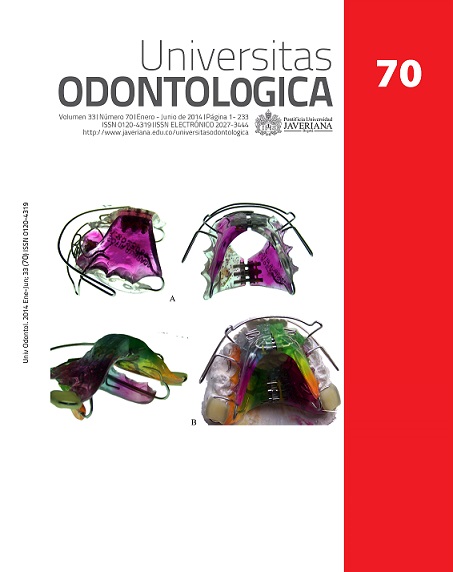Resumen
Antecedentes: La contribución genética de la fisura labial y/o palatina no sindrómica (FLPNS) puede expresarse en los padres como microformas, a manera de alteraciones fenotípicas faciales o asimetría de huellas dactilares. Propósito: Determinar dichas características en padres de niños con FLPNS, a fin de establecer si son un factor de riesgo de presentar la fisura en su descendencia. Métodos: El estudio incluyó dos grupos: estudio con 60 padres (43 mujeres y 17 hombres) de 46 niños con FLPNS y control con 50 padres (36 mujeres y 14 hombres) de niños sin historia de FLPNS en la familia procedentes de la ciudad de Bogotá. Se tomaron medidas en fotografías de frente y perfil y se analizaron las huellas dactilares. Resultados: Los padres de niños con FLPNS mostraron asimetrías fluctuantes en la distancia nasion-ala nasal derecha e izquierda, diferencias en la longitud de las orejas izquierda y derecha, y asimetría en la distancia arco de Cupido-comisura labial izquierda y derecha. Adicionalmente, los padres de niños con FLPNS mostraron incremento en el tercio facial superior e inferior, aumento en la distancia intercantal e interalar y diferencias estadísticamente significativas en la presencia de la característica presilla radial izquierda y asimetría en el verticilo. Conclusiones: Existe una asociación entre asimetrías faciales fluctuantes en los padres y la presencia de FLPNS en su descendencia. El análisis de huellas muestra características específicas y diferentes en los padres de niños con FLPNS comparadas con padres de niños sanos.Esta revista científica se encuentra registrada bajo la licencia Creative Commons Reconocimiento 4.0 Internacional. Por lo tanto, esta obra se puede reproducir, distribuir y comunicar públicamente en formato digital, siempre que se reconozca el nombre de los autores y a la Pontificia Universidad Javeriana. Se permite citar, adaptar, transformar, autoarchivar, republicar y crear a partir del material, para cualquier finalidad (incluso comercial), siempre que se reconozca adecuadamente la autoría, se proporcione un enlace a la obra original y se indique si se han realizado cambios. La Pontificia Universidad Javeriana no retiene los derechos sobre las obras publicadas y los contenidos son responsabilidad exclusiva de los autores, quienes conservan sus derechos morales, intelectuales, de privacidad y publicidad.
El aval sobre la intervención de la obra (revisión, corrección de estilo, traducción, diagramación) y su posterior divulgación se otorga mediante una licencia de uso y no a través de una cesión de derechos, lo que representa que la revista y la Pontificia Universidad Javeriana se eximen de cualquier responsabilidad que se pueda derivar de una mala práctica ética por parte de los autores. En consecuencia de la protección brindada por la licencia de uso, la revista no se encuentra en la obligación de publicar retractaciones o modificar la información ya publicada, a no ser que la errata surja del proceso de gestión editorial. La publicación de contenidos en esta revista no representa regalías para los contribuyentes.


